Statement: The data in this article is derived from the annual reports of various platforms and other research reports, and the reference standards may vary.
DeFi and NFT Cultivate the Development Soil of GameFi
DeFi and NFT Lay the Foundation for GameFi
Since the launch of the Ethereum mainnet on July 30, 2015, it officially heralded the arrival of the Web3 era. The smart contract deployment function of the Ethereum mainnet supports the design and operation of DAPPs (decentralized applications). Based on this, a large number of popular DeFi (decentralized finance) projects have emerged, such as Uniswap, which implements DEX (decentralized exchange) through automated market makers, and MakerDAO, which implements contract lending. These DeFi projects, with characteristics such as high investment returns, public transparency, strong privacy, and complete openness, have attracted a large amount of hot money. The total market value of the DeFi track has grown from $50 million in 2015 to $100 billion in 2023.
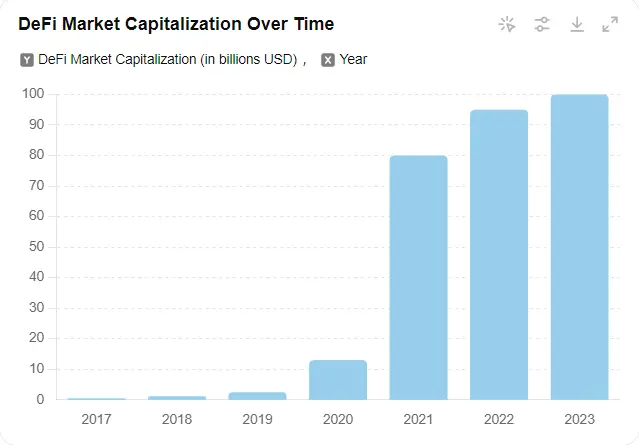
Figure 1: Growth of DeFi Market Value
While DeFi was booming, capital began to continuously explore the combinability of decentralized finance with other areas. During this period, the NFT market experienced a major outbreak. In 2017, CryptoKitties, an NFT project based on Ethereum, where players can buy, breed, and trade digital cats, attracted widespread attention and is often considered the starting point of the NFT explosion. The total market value of the NFT market has risen from a few million dollars in 2018 to $8 billion in 2023.
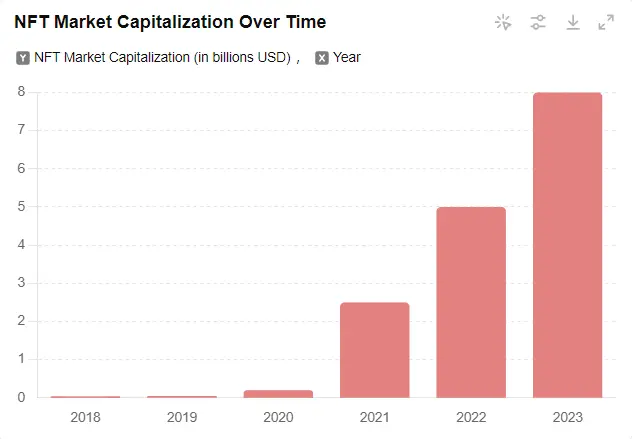
Figure 2: Growth of NFT Market Value
If DeFi has brought a continuous stream of funds to the cryptocurrency market, then NFT has shifted the focus of blockchain to entertainment and gaming. Under the combined influence of the two, a fertile ground has been provided for the development of blockchain games, and under this, GameFi, which combines the concepts of DeFi and blockchain games, has begun to emerge.
The Beginning of the Dream of GameFi
In the second half of 2019, Mary Ma, the Chief Strategy Officer of MixMarvel, first proposed the concept of GameFi - "gamified finance" and "a completely new gamified business." This concept combines elements of gaming and finance, aiming to introduce new business models and economic systems to the gaming industry through blockchain technology. In Mary Ma's view, the future of games is not only an entertainment tool but can also become a financial tool. Through blockchain technology, virtual items in games can become valuable digital assets, and players can obtain, trade, and appreciate these assets through games. In this model, game companies and players can participate in economic activities in a decentralized environment, achieving mutual benefit.
However, due to the immaturity of blockchain technology and its application paradigm at the time, the concept of GameFi did not immediately attract widespread attention and application.
The Start of the GameFi Explosion
In September 2020, Andre Cronje, the founder of Yearn.finance, detailed his understanding and prospects of GameFi in a speech and public statement, and with Andre Cronje's authority in the DeFi industry, the concept of GameFi truly entered the public eye. Many of Andre Cronje's views on GameFi also clarified the future development direction of GameFi.
In Andre Cronje's concept, the DeFi industry is in the "TradeFi" (trade finance) stage, where users' funds are mainly used for trading, pledging, and borrowing, failing to reflect the differences between cryptocurrencies and traditional finance. GameFi will serve as the future development direction of DeFi, where user funds can not only be used for financial transactions but will also have practical application value in the virtual gaming world, allowing users to earn substantial token rewards in activities within the virtual gaming world, similar to real-life work.
Since then, the GameFi field has begun to experience its first wave of growth!
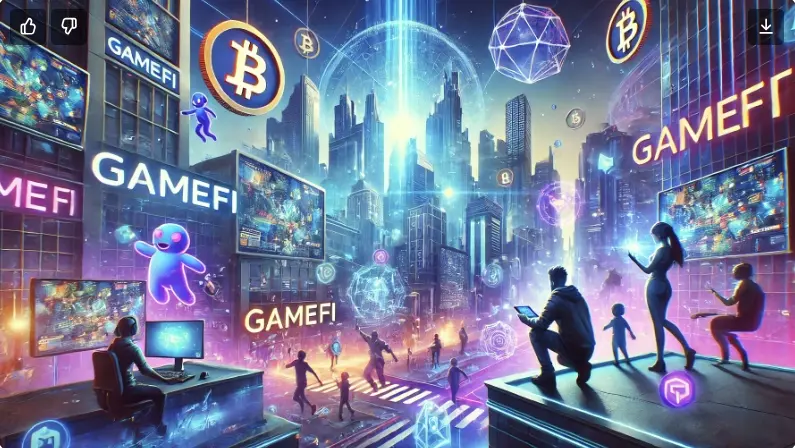
Figure 3: GameFi Promotional Image
GameFi Reshaping the Gaming Track
GameFi is a blockchain technology that combines DeFi, NFT, and Blockchain Game (chain game), where the assets of the game and some logic are run in smart contracts on the blockchain, and are managed by DAOs (decentralized autonomous organizations) to ensure users' ownership of game assets and governance rights over the game. GameFi focuses on building a complete financial system, supporting activities such as trading props using native game tokens. Users can earn token rewards through games and share in the benefits of game development.
Completely Solving the Ills of Traditional Games
In traditional games, items such as props and skins have a certain value, which has long been a consensus. The average annual sales of items in CSGO from 2018 to 2023 exceeded $420 million and increased year by year; the annual sales of skins in League of Legends increased from $1.4 billion in 2018 to $2.5 billion in 2023; the annual sales of skins in Honor of Kings reached an exaggerated $2.74 billion in 2023. Whether domestically or internationally, game items have a broad market space.
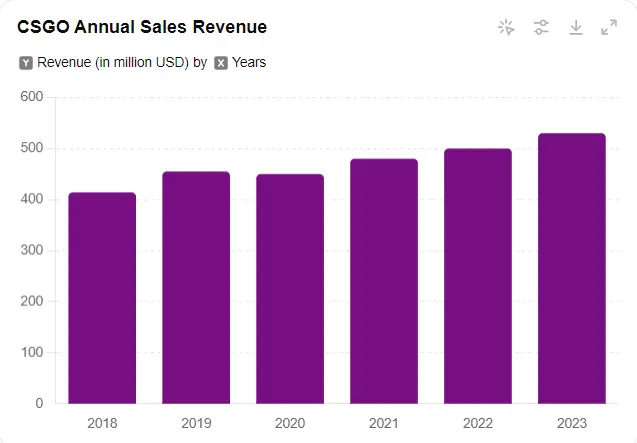
Figure 4: CSGO Annual Sales of Items
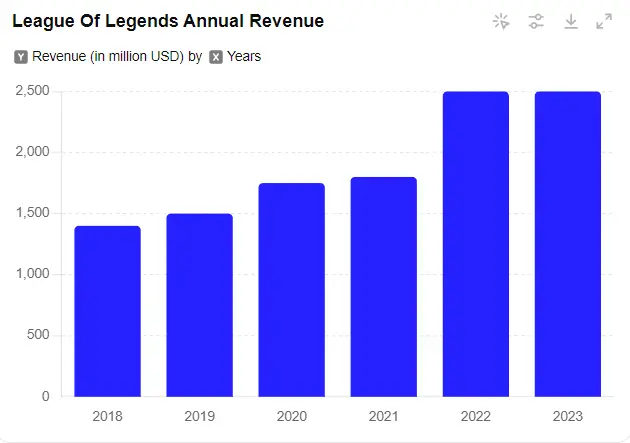
Figure 5: League of Legends Annual Sales of Items
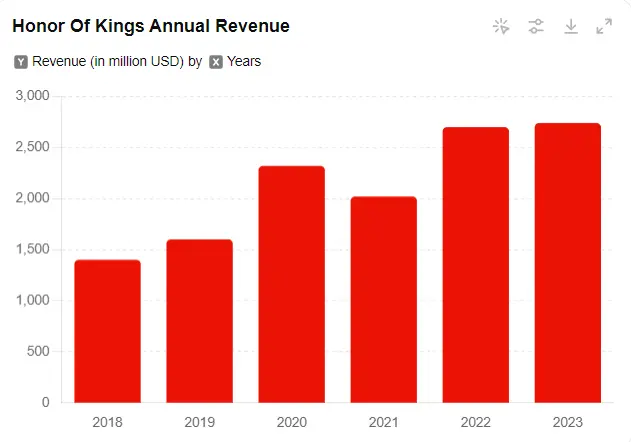
Figure 6: Honor of Kings Annual Sales of Items
However, due to the fact that item transactions often damage the profits of game publishers and touch upon certain legal red lines in some countries and regions due to their financial attributes, game companies have always adopted two strategies for item transactions. One is the monopoly of item trading markets, such as CSGO's collaboration with Steam, which charges high transaction fees, and the other is unlimited item supply, unified item purchase channels, and strict prohibition of game account trading, as seen in League of Legends and Honor of Kings.
Due to the prohibition by game publishers and local regulations, the black market sale of game items has become a highly profitable business. To a certain extent, as game publishers and local regulations intensify their crackdown on black market transactions, the supply of black market items shifts left, increasing sales profits.
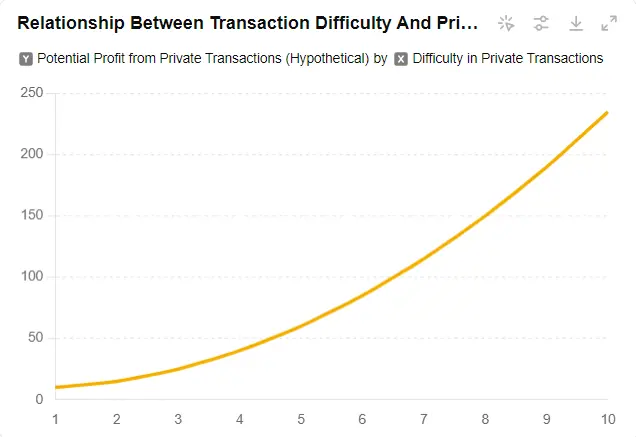
Figure 7: Rough Curve Relationship between Private Trading Profits and Trading Difficulty
GameFi, built on blockchain technology, naturally possesses DeFi attributes and can perfectly solve the current situation of game publisher monopolies and rampant black markets. GameFi is both a game and a market, where game skins and items exist in the form of NFTs, and all transactions will follow the market's natural laws and strive to remain transparent.
In addition, one of the major features of GameFi is the governance of game development through DAO, allowing all players to share the governance rights of the game. Currently, game publishers often manipulate the probability of lottery draws and reduce the prices of certain previously high-priced game items to increase sales, which harms the interests of players who have already made purchases. Protests from players against these measures are often difficult to coordinate and are often overshadowed by these tech giants through traffic control. The implementation of DAO governance measures can shatter the current situation of absolute discourse power of game publishers, and users no longer have to worry about the game developing in a direction that is unfavorable to them, enjoying the overall economic benefits brought about by the development of the game.
Perfectly Fits the Development History of Games
Looking at the development history of games, it often revolves around important factors such as the improvement of computer technology, hardware upgrades, and innovative game concepts.
- Early Computer Game Era (1970s-1980s): The early stage of electronic game development, mainly concentrated in laboratories and university environments. Notable early games include "Spacewar!" and "Pong," with the release of "Pong" marking the beginning of commercial electronic games.
- Home Game Console Era (1980s-1990s): Nintendo released the home game console NES, bringing classic games such as "Super Mario Bros."
- 16-bit Game Console Era (1990s): Sony released the PlayStation, ushering in the era of CD games, and the game "Final Fantasy VII" sparked a gaming craze.
- 3D Game Era (late 1990s-early 2000s): Valve released "Half-Life," which won widespread acclaim from players for its deep storyline and immersive experience.
- Online Games and MMORPG Era (2000s): Blizzard Entertainment released "World of Warcraft," becoming one of the most successful MMORPGs and driving the development of online multiplayer games.
- Mobile Games and Social Games Era (2010-present): Supercell released "Clash of Clans," becoming one of the most successful mobile strategy games, and Niantic released "Pokémon GO," combining augmented reality (AR) technology with mobile games, sparking a global craze.

Figure 8: Traditional Game Development Line
In the past, the development of games mainly relied on three key elements: the improvement of computer technology, hardware upgrades, and innovative game concepts. Today, GameFi, as a combination of DeFi and NFT, represents one of the most cutting-edge and interesting technologies in blockchain; it is also a cross-disciplinary fusion of computer science and finance, with the novel concept of "play-to-earn" games; it also provides an example for financial market research. It can be said that GameFi perfectly fits two of the three key elements in the development history of games, aligning with the historical development of games.
In recent years, GameFi has experienced rapid development and has given rise to many top projects.
- Early Exploration (2018): Decentraland was launched as one of the early GameFi projects, allowing players to buy, develop, and trade virtual land, achieving true ownership through blockchain technology. Gods Unchained introduced a blockchain-based collectible card game, where players can buy, sell, and trade cards, demonstrating the potential application of NFTs in games.
- Concept Proposal (2019): Mary Ma proposed the concepts of "gamified finance" and "a completely new gamified business," marking the birth of the GameFi concept. In the same year, Axie Infinity, launched by Sky Mavis, began to gain attention from the public.
- Initial Rise (2020): The founder of Yearn.finance, Andre Cronje, reiterated the concept of GameFi in September 2020, predicting that DeFi would evolve into a gamified finance stage, where user funds would be used as equipment in games. At this time, the DeFi and NFT markets also entered a golden period, laying the groundwork for the explosion of GameFi.
- Explosive Growth (2021): Axie Infinity achieved tremendous success, attracting millions of players and reaching a daily trading volume of $1 million in August, allowing players to earn income through the "play-to-earn" model, becoming the main source of income for hundreds of thousands of residents in Southeast Asian countries during the pandemic. The Sandbox also gained popularity, allowing users to create, own, and trade virtual assets and land, attracting significant attention from venture capital firms.
- Sharp Decline in Traffic (2022-present): Influenced by the overall downturn in the cryptocurrency market, GameFi's popularity has significantly declined. Axie Infinity's daily active users plummeted from 740,000 in August 2021 to 35,000 in August 2022. Additionally, many GameFi projects are facing serious inflation issues, with the token supply of DeFi Kingdoms increasing from 60 million in early 2022 to 100 million in mid-2022.
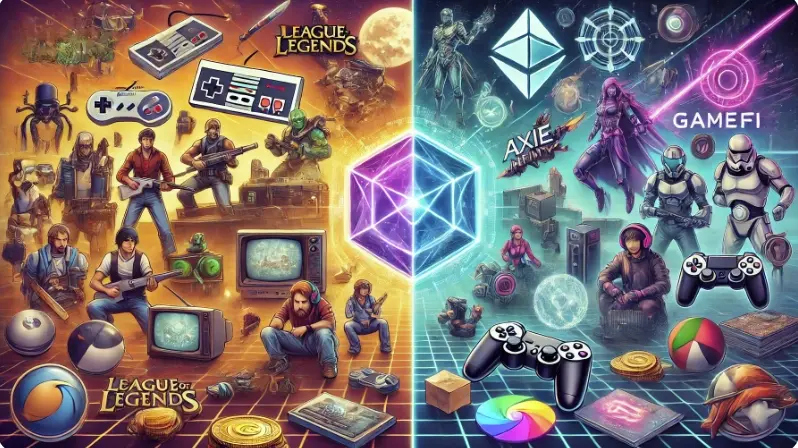
Figure 9: Game vs GameFi
The explosion of GameFi has also driven the concept of the metaverse, which essentially aims to build a virtual shared space achieved through augmented reality (AR) and virtual reality (VR) combined with decentralized technologies such as blockchain, covering not only games but various aspects of life. The free ecological development of GameFi has made it a synonym for the metaverse in many scenarios. In the years 2021 to 2022, many traditional tech companies began to get involved in the concepts of GameFi and the metaverse.
- Facebook renamed itself Meta, reflecting its long-term vision for the metaverse.
- Tencent established a new studio, TiMi Studios, focusing on developing metaverse-related games, and invested in The Sandbox and Decentraland.
- Microsoft acquired Blizzard for $68.7 billion, planning to integrate traditional popular games with blockchain technology to create a new generation of GameFi.
- Goldman Sachs and SoftBank increased their investments in GameFi, supporting well-known GameFi projects such as Axie Infinity and The Sandbox.
The overall market value of GameFi has also increased from $200 million in 2018 to $24.52 billion in 2023, with a growth rate of up to 733.3% from 2020 to 2021.
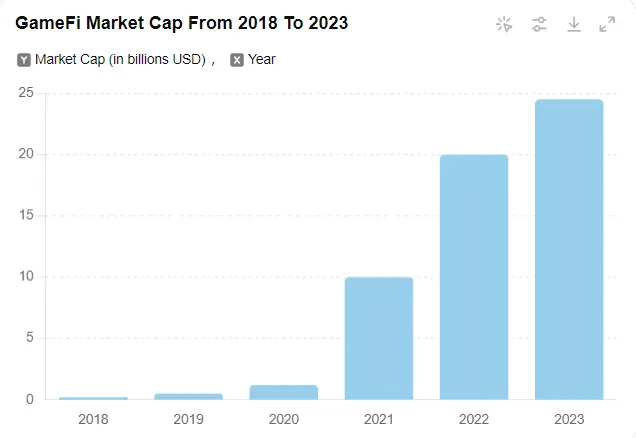
Figure 10: GameFi Market Value Growth Chart
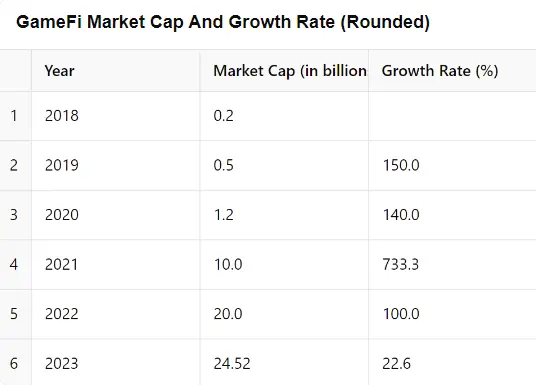
Figure 11: GameFi Market Value Growth Rate
Although GameFi may currently face some challenges, with the strong involvement of traditional tech companies and the gradual maturity of technology, it still has unlimited potential in the future.
A Narrative of Gathering the Best of All
GameFi itself is a combination of DeFi+NFT+Blockchain Game, making DeFi more vivid and providing NFT technology with landing opportunities. The governance model of GameFi also provides an opportunity for the implementation of DAO organizations. Combined with the current hot concepts such as the metaverse, AR, and VR are also expected to become part of the grand works of GameFi 3A. Therefore, GameFi is an application field that deeply applies blockchain technology and aligns with virtual technology.
DeFi+NFT Token Economy, Building an Independent Financial Ecosystem
The financial characteristics are the biggest difference between GameFi and Blockchain Game. Blockchain Game often focuses on using blockchain technology to enhance game transparency, fairness, and asset ownership, while GameFi focuses on integrating the complete financial system into the game, creating a Blockchain Game with financial attributes. Therefore, a Blockchain Game can be a simple blockchain application game, while GameFi necessarily includes financial functions and an economic system.
From a technical perspective, the uniqueness and indivisibility of NFTs give each game item unique value. By limiting the issuance of NFT items, scarcity value can be created.
From a rights perspective, in GameFi, the project party only appears as a game developer, bug fixer, and resolution initiator. At the beginning of the game, they sell tokens and item NFTs to players, while giving most of the power to ordinary players. The update and development of the game, as well as the distribution of benefits, are decided by a DAO organization composed of players and the project party.
From a mechanism perspective, the "play-to-earn" model in GameFi allows players to earn NFT items or tokens in the game through time and early financial investment, and exchange them with real-world fiat currency, generating economic benefits.
Integrating the financial system into games is not unique to GameFi. Some traditional games already have complex financial systems, proving that this initiative is feasible. The MMORPG game "EVE Online" is known for its complex financial system, simulating real-world markets, including production, trade, resource management in combat, and more. The game has over 40,000 items, and players can mine resources, manufacture goods, establish companies and alliances, and even engage in market manipulation. The developer of "EVE Online," CCP Games, hired economist Eyjólfur Guðmundsson to study the economic operation mechanism within the game and timely regulate the vast market to prevent market collapse.
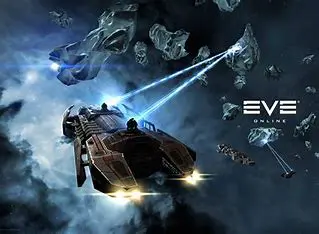
Figure 12: Promotional Image of "EVE Online"
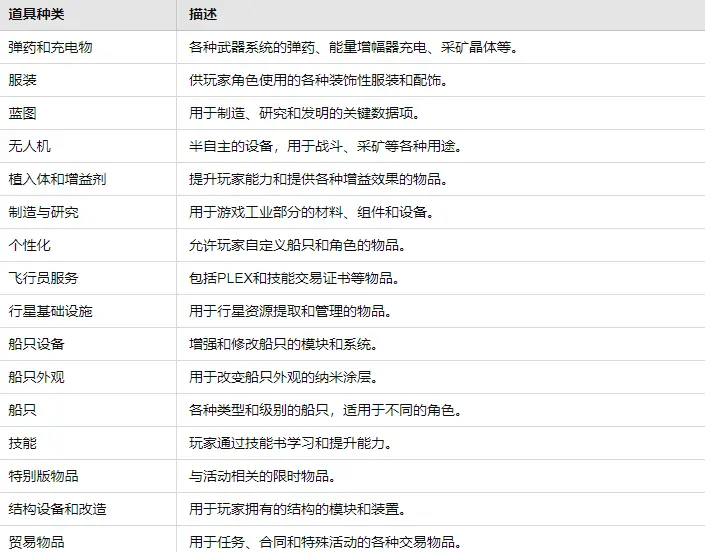
Figure 13: Some Game Items in "EVE Online"
Although the complexity of the financial system in GameFi is far from that of traditional games like "EVE Online," "World of Warcraft," and "Second Life," its decentralized nature ensures that GameFi players have ownership of assets without the risk of trusting game publishers.
Cross-Chain Asset Interoperability + Multi-Platform Operation, Creating a Large Financial Circle
A single GameFi may face issues such as low user numbers, low activity, and unstable funds. Cross-chain asset interoperability and multi-platform operation may help address these issues. Each GameFi is an economic entity, and when GameFi is interconnected, it can form a large economic market. This requires the comprehensive application of cross-chain, cross-platform compatibility, data synchronization and consistency, decentralized account management, and other technologies.
Cross-chain technology: Allows users to directly trade and communicate between different blockchains through cross-chain bridge technology or interoperability protocols.
Cross-platform compatibility: At the beginning of GameFi development, it is important to ensure that it can run in different hardware and software environments. The use of highly compatible game engines such as Unity and Unreal Engine, as well as standardized APIs, is crucial for achieving cross-platform compatibility.
Data synchronization and consistency: State Channels technology allows users to complete transactions off-chain and only submit the final state to the blockchain for information synchronization, reducing data transmission pressure.
Decentralized account management: When supporting cross-chain and multi-platform operations in GameFi, technologies such as DID (decentralized identity), SSO (single sign-on), and distributed account storage become important. Through these technologies, the pressure of managing user accounts can be reduced, and security can be improved.
A unified and effective financial cycle can not only increase the liquidity of funds within the cycle but may also, as Andre Cronje hopes, become the direction of future DeFi development. In addition, the financial cycle of GameFi will simulate the financial behaviors between countries and regions in the real world, providing examples for further economic research.
Integration of AR, VR Technologies, "Ready Player One" is No Longer a Fantasy
Benefiting from the explosive growth of GameFi in 2021, the concept of the metaverse once dominated the A-share and U.S. stock markets. During this period, there were numerous fraudulent activities under the guise of the metaverse concept. In this context, GameFi gradually became the hope to carry on the concept of the metaverse.
At the same time, AR and VR technologies associated with the metaverse began to flourish. The global AR and VR market size exceeded $70 billion in 2023 and is expected to surpass $400 billion by 2030.
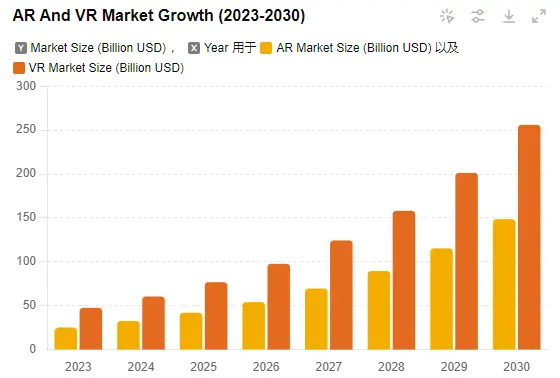
Figure 14: Estimated Market Size of AR and VR
Many projects have begun to focus on the underlying implementation of the integration of blockchain with AR and VR technologies, making it possible for GameFi to combine AR and VR technologies and bring "Ready Player One" into reality.
Render Network: Provides distributed GPU rendering services, supporting high-quality 3D rendering for AR and VR. Many applications, including Apple Vision Pro, already offer this service.
Ozone: Provides 3D application and cloud computing services that support multi-chain and cross-chain operations.
IOTX: Provides a secure, privacy-protecting, and scalable blockchain platform for connecting and managing IoT devices.
In the face of such future demand in the virtual market, the integration of AR and VR technologies with GameFi to create a new generation of 3A games has gradually become a consensus.
The GameFi 1.0 Era, the Fast-Paced Ponzi Game
CryptoKitties, the Crazy Cats that Started the GameFi 1.0 Era
On November 28, 2017, CryptoKitties entered the Ethereum blockchain, becoming the first phenomenon-level DApp. Its appearance proved to users that Ethereum is not only about token issuance but also about simple and fun NFT games. CryptoKitties offered a series of innovative gameplay features.
- Users could use ETH to purchase their own cat NFT in the CryptoKitties marketplace.
- Each cat had a unique genetic code, and users could search for the cat's parents, siblings, and past activities in the marketplace.
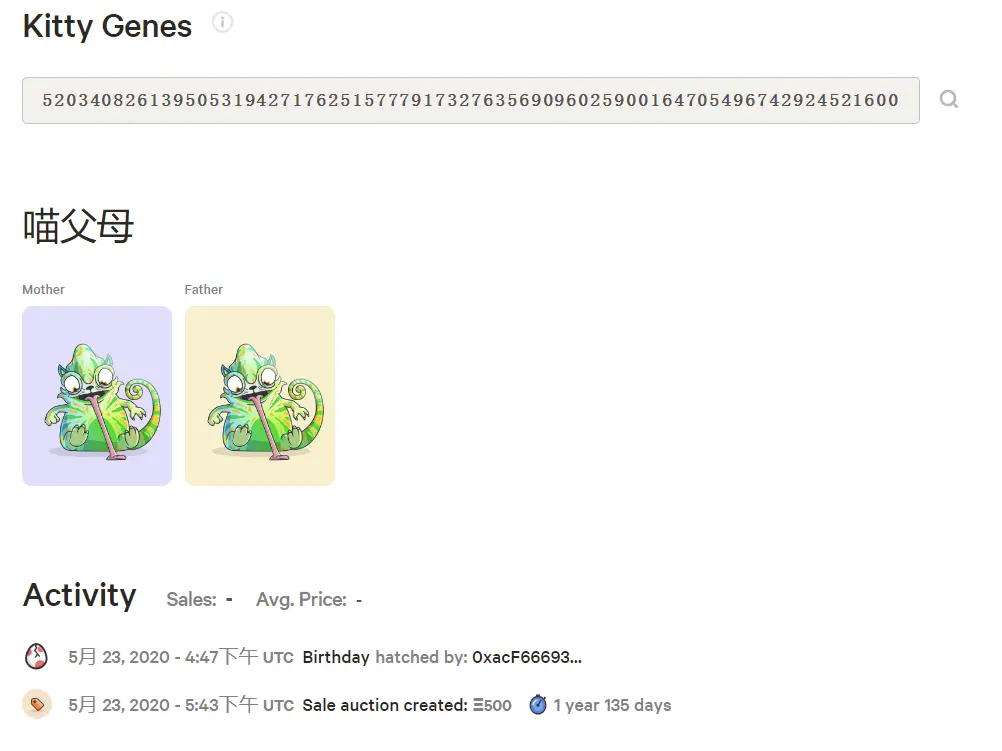
Figure 15: CryptoKitties Information
Two cats could breed to produce a new generation of kittens. After breeding, the cat would have a cooldown period, which would increase in length with each breeding, and the cooldown time would be inherited by the new generation of kittens.
Players could rent out their cats for breeding with other players' cats, give their cats as gifts to others, or auction them in the marketplace.
The innovative gameplay of CryptoKitties and the high expected returns quickly attracted the attention of speculators. One cat named "Dragon" was sold for 600 ETH (approximately $170,000), setting a historic record. The CryptoKitties project also separated from its original company, Axiom Zen game studio, and received a $12 million investment from top venture capital firms a16z and USV.
As of 2024, the CryptoKitties project has conducted over 700,000 transactions, with a total transaction volume of 67,818 ETH, equivalent to approximately $115 million. However, since the mid-2018, the transaction volume of the CryptoKitties project has experienced a steep decline and has completely detached from the market hype.
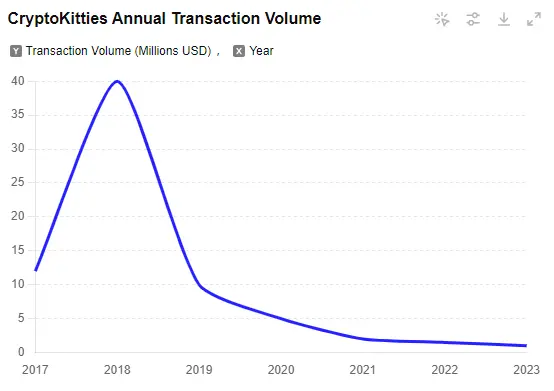
Figure 16: CryptoKitties Transaction Volume Changes
Although the original intention of the CryptoKitties project was not a Ponzi scheme, but rather to explore more channels for the future development of Ethereum through NFT games, it has caused a very serious economic bubble.
Fomo3D - Purely a Gambling Game
The popularity of CryptoKitties sparked the early explosion of Blockchain, but most of these Blockchains did not have any innovative points, with the most well-known project being Fomo3D. Fomo3D is a simple mechanism-based gambling game, mainly consisting of four types of gameplay. The core mechanism is a treasure hunt, and it is complemented by a team bonus mechanism, a referral reward mechanism, and a lucky candy mechanism to increase profitability.
The treasure hunt mechanism targets gamblers. In Fomo3D, each full game includes a 24-hour countdown, and during the countdown, players spend Ethereum to purchase tokens called "Keys" in the game. Each time a player purchases a "Key," the countdown increases by 90 seconds (no longer increasing after 24 hours). In the end, the player who becomes the last to buy at least 1 "Key" when the 24-hour countdown ends can take away 48% of the prize pool. To ensure that a full game can end, Fomo3D continuously adjusts the price of "Keys." After each purchase of a "Key," subsequent players need to spend a higher price to purchase. As the cost of player participation increases, there may be a situation where the countdown speed is faster than the 90-second increase, ultimately ending the game.
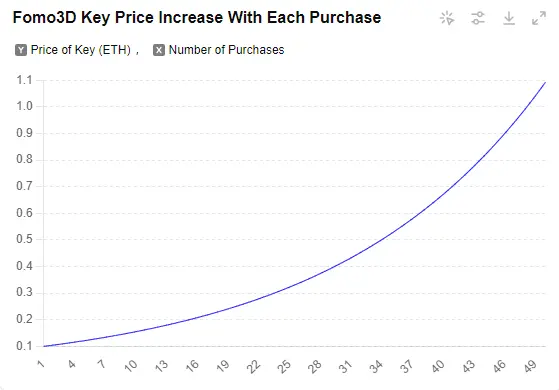
Figure 17: Changes in "Key" Prices in Fomo3D
It is obvious that Fomo3D is a typical Ponzi game, where everyone hopes to be the ultimate winner, but most end up losing everything.
Ponzi scheme Blockchain Games like Fomo3D were the norm in the GameFi 1.0 era, almost all of them were Ponzi schemes that robbed new users to reward old users. The fragile balance under high returns is very susceptible to collapse due to factors such as selling off the native currency, loss of hype, and a decrease in new users. In terms of entertainment, these Blockchain Games cannot compare to traditional games. Therefore, fundamentally speaking, the Blockchain Games of this era did not have a complete financial system and cannot be called GameFi.
The GameFi 2.0 Era, Inspired by "Play-to-Earn"
The GameFi 2.0 era is a stage of vigorous development of the GameFi concept, expanding the financial system of Blockchain step by step from "play-to-earn" to "x-to-earn," gradually introducing financial elements such as community, trading, combat, and market into GameFi.
Axie Infinity Ignites the "Play-to-Earn" Trend
Unlike all previous Blockchain Games, Axie Infinity was the first to combine the "play-to-earn" concept with complex financial mechanisms, creating an attractive NFT creature world where players can collect, breed, battle, and trade creatures called Axies.
Early stage (2018): Axie Infinity was released by the Vietnamese startup team Sky Mavis, with the initial inspiration coming from "Pokemon" and CryptoKitties. The team aimed to create a player-autonomous creature world.
Early development stage (2019-2020): Axie Infinity officially launched on the Ethereum blockchain, allowing players to purchase Axies for breeding and sale in the marketplace. Subsequently, Axie Infinity introduced PVP mode and adventure systems, further increasing the game's playability.
Explosive growth period (2021): Due to the "play-to-earn" mode in the game, Axie Infinity attracted a large number of players, and an article titled "Playing and Earning - NFT Games in the Philippines" brought more attention to this promising game.
Expansion stage (2022-present): Axie Infinity has quietly developed, and currently consists of six sections: Axie Infinity Origins, Axie Infinity: Homeland, Axie Classic, Axie Infinity: Raylights, Defenders of Lunacian, and Project T prototype.
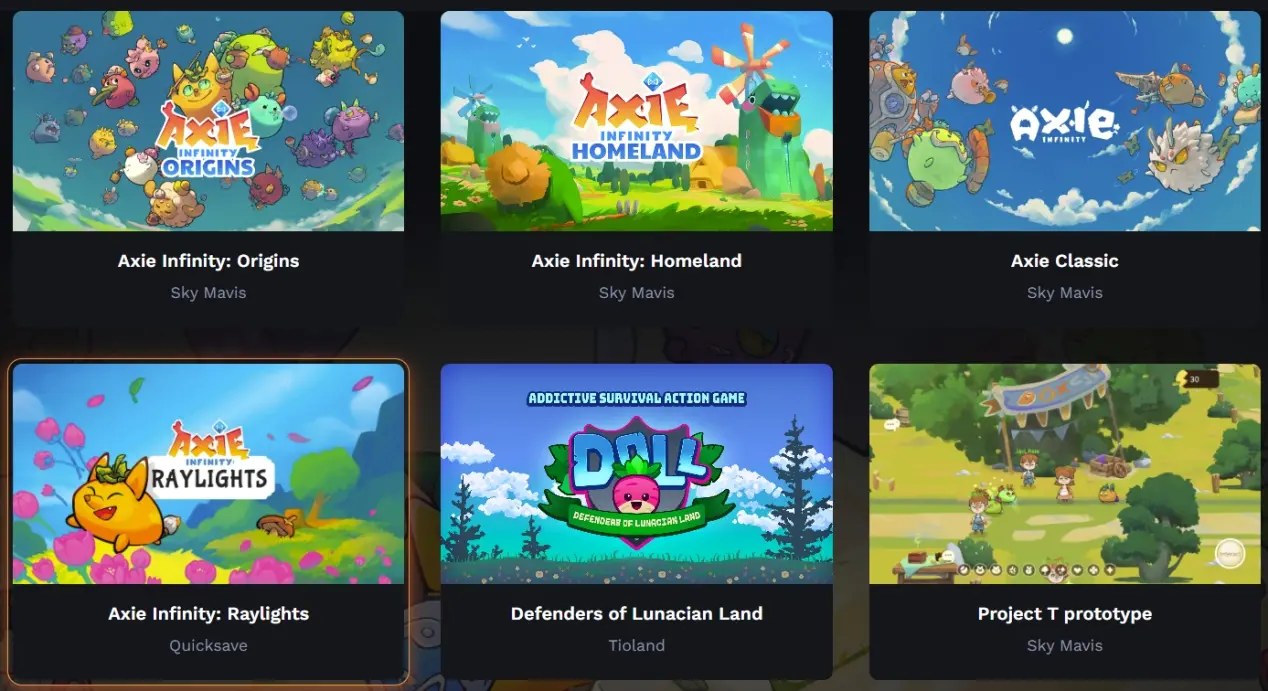
Figure 18: Axie Infinity Game Mode
In the Axie Classic version, users need to start battling or breeding by purchasing 3 Axies. Each Axie is unique and fully owned by the player. Axies are born with randomly assigned attribute inclinations, including health, skills, speed, and morale. Axies also have different racial attributes that provide certain restraint relationships during battles. There are many details in the specific game rules, which will not be elaborated on here.
The Axie Infinity token governance model is a dual-token governance, with AXS as the governance token and SLP as the game token.
Role of AXS
- AXS holders have voting rights for the governance of the Axie Infinity ecosystem, including the future development direction and major decisions of the game.
- Players can stake AXS tokens to earn rewards.
- When breeding Axies, a portion of AXS is required as breeding fees.
- AXS also serves as the reward token for in-game events.
Role of SLP
- SLP is mainly used for Axie breeding, with each breeding requiring a certain amount of SLP. The more breedings, the more SLP is required.
- Players can earn substantial SLP rewards by completing daily tasks, participating in PVE (adventure mode), and PVP (arena mode).
Unique Scholarship Mechanism
Axie Infinity has a unique scholarship mechanism, where Axie holders can lend out their Axies to scholars, who can battle with the Axies to earn SLP, and the holders can receive a share of the earnings. Under this mechanism, diligent and knowledgeable players can enter the game with zero barriers and continuously earn AXS and SLP to grow their Axie team. During the pandemic, a large number of Filipinos sustained their basic living through the Axie game, making it a rare case of a blockchain project truly improving people's lives.
The creative achievements of Axie Infinity are also reflected in the project's monthly active users (MAU), transaction volume, and revenue. In August 2021, Axie Infinity's total transaction volume exceeded $2 billion, with a monthly revenue of $364 million, surpassing "Honor of Kings" for the first time. By the end of the same year, the monthly active user count reached over 2 million.
Although Axie Infinity made groundbreaking breakthroughs in the development of GameFi, it has still been affected by economic bubbles and the overall market downturn. Its active user count decreased from a peak of 2.7 million in 2021 to 400,000 in 2023, and the current monthly user count is only around 100,000, with its transaction volume decreasing from $4 billion in 2021 to $200 million in 2023.
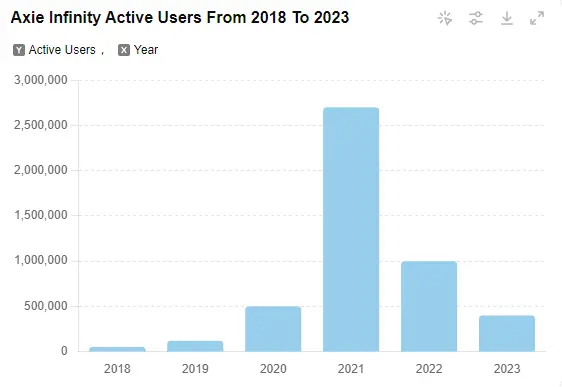
Figure 19: Axie Infinity Active User Changes
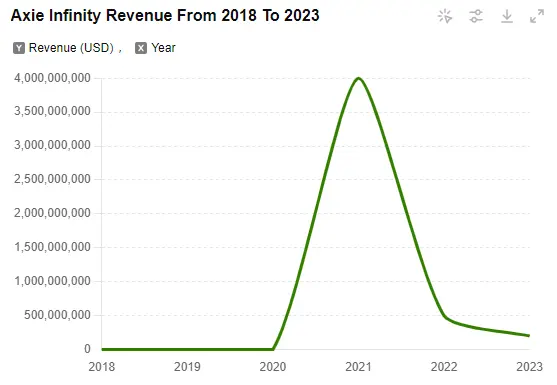
Figure 20: Axie Infinity Annual Sales Changes
Despite experiencing a massive economic bubble, Axie Infinity has withstood the turmoil and still maintains its leading position in GameFi. In the past 30 days, the number of Axie transactions has reached as high as 387,232, with sales totaling 1083.3 ETH, approximately $4 million, which is very impressive data for a game that has been around for six years.

Figure 21: Overview of Axie Sales in the Past 30 Days
Axie Infinity first put into practice the concept and model of GameFi through the "play-to-earn" mode, and successfully attracted people who truly enjoy the game through PEP and PVP modes, making it a successful example in GameFi.
The Sandbox Shaping the Virtual World
If Axie Infinity is a casual game in GameFi, then The Sandbox is definitely a masterpiece. The Sandbox originated from two popular sandbox games, "Sandbox" and "Sandbox Evolution," with a total of over 40 million downloads on iOS and Android systems. In 2018, the publisher Pixowl decided to bring this successful user-generated content game IP and a large creator community from mobile devices into the blockchain ecosystem, providing real intellectual property to creators through NFTs and rewarding their contributions to the community in the form of tokens. Thus, The Sandbox, this great work, was born.
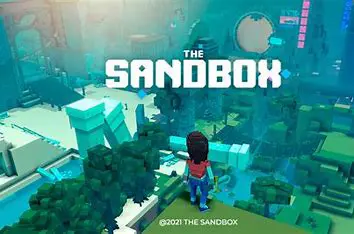
Figure 22: The Sandbox Promotion
From a technical perspective, The Sandbox inherits the UGC (user-generated content) ecosystem of past sandbox games and provides three integrated functions, VoxEdit, MakeTPlace, and Game Maker, to provide users with a comprehensive design experience, while also supporting copyright protection for successful designs through blockchain and smart contracts.
From a token model perspective, The Sandbox provides three tokens to ensure the economic cycle within the game, namely SAND, LAND, and ASSETS (material assets).
- SAND follows the ERC-20 standard and is the token required for players to obtain material assets, purchase land, and publish content in The Sandbox game. SAND also has ecological governance functions and allows for staking to earn SAND rewards.
- LAND follows the ERC-721 standard and represents land assets in the game. Each piece of LAND is sized at 96*96, and players can add game and material assets to their LAND and establish their own game rules after purchasing LAND. Multiple pieces of LAND can form larger ESTATES, suitable for creating larger and more content-rich sandbox games.
- ASSETS follow the ERC-1155 standard and are tokens generated by creators to prove ownership, which can be sold on The Sandbox's front-end webpage.
The Sandbox, with its strong IP effect, innovative game concept, and open financial system, has been highly sought after by capital. In 2018, Animoca Brands acquired Pixowl and provided long-term assistance for The Sandbox development. In 2019, The Sandbox received a $2.5 million seed round investment led by Hashed. In 2020, The Sandbox raised $3 million in Series A financing from institutions such as True Global Ventures and Square Enix. In 2021, The Sandbox's strong ecosystem, distinct from low-quality Blockchain Games, was discovered by SoftBank, and it received a $93 million investment led by SoftBank in its Series B financing.
The Sandbox has not disappointed major investment institutions. Since the sale of LAND began, the average price has continued to rise, and the floor price on the NFT exchange OpenSea remains as high as 0.12 ETH.
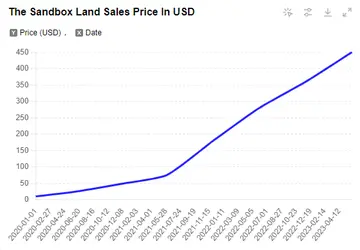
Figure 23: Average Sale Price of LAND Changes
In addition, many core location LANDs have been sold at sky-high prices. In November 2021, virtual real estate investment company Republic Realm purchased a virtual land in The Sandbox for $4.3 million, and the adjacent LAND of Snoop Dogg was sold for approximately $450,000 the following month.
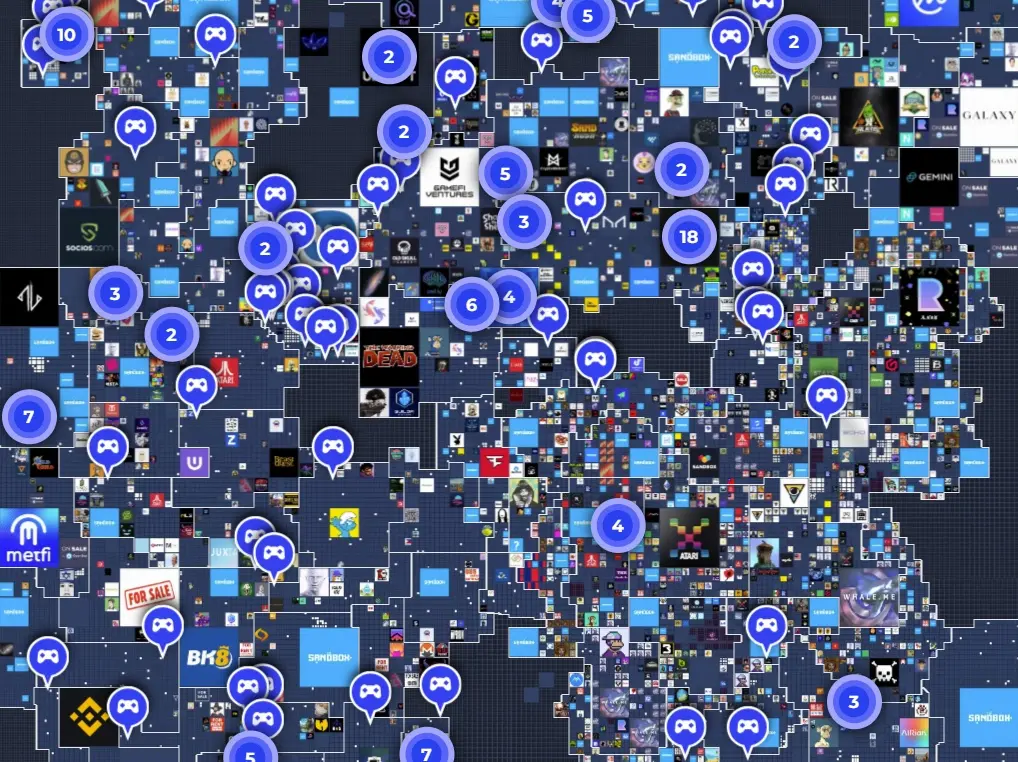
Figure 24: Partial Map of LAND Distribution
The market value of The Sandbox has fluctuated significantly since its ICO, reaching a peak of $6.8 billion and currently standing at a high of $700 million, making it difficult to estimate the profits obtained by venture capital firms investing in The Sandbox.
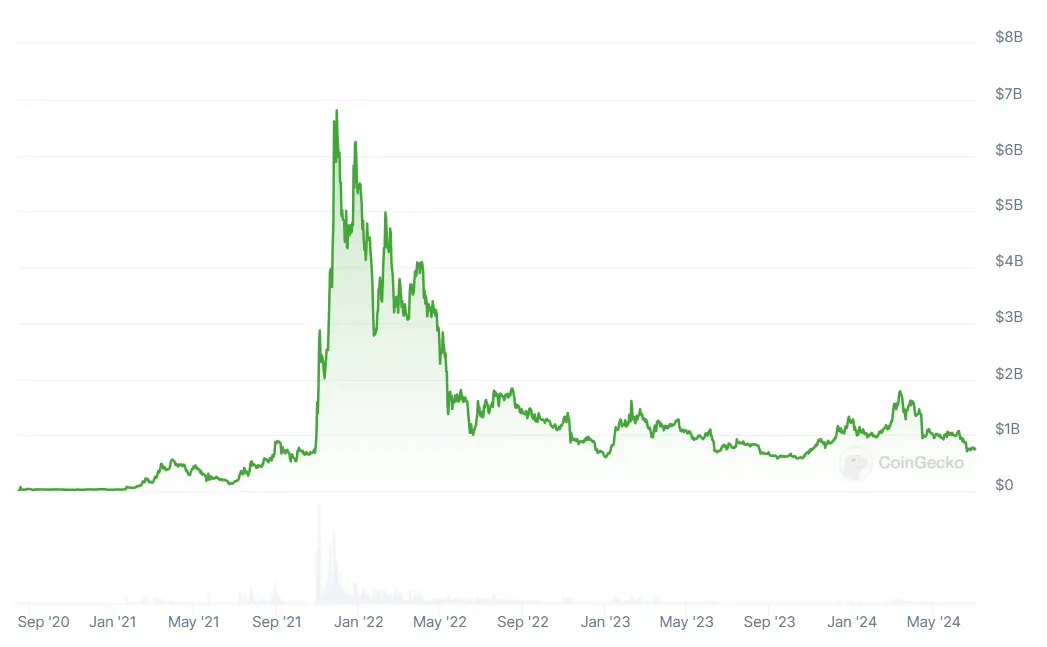
Figure 25: The Sandbox Market Value Changes
Overall, the emergence of The Sandbox provides an example of the combination of traditional IP and blockchain technology and demonstrates the powerful wealth aggregation effect of high-quality GameFi.
GameFi 3.0 Era: Exploring the Future GameFi Market
Mini Games are Not GameFi
Recently, Telegram mini-games such as Not and Hamster have become popular, allowing users to earn tokens with just a few taps on the screen. These simple operations have led to viral community growth, with participation reaching tens of millions of users in a short period. Since its launch in January 2024, the Not game has attracted over 30 million participants, with a daily active volume of up to 5 million. Subsequently, Notcoin successfully conducted an ICO on multiple exchanges, including Binance, with a 7-day increase of over 400%.
However, these games are built on Telegram and can only be considered as Mini Games, lacking a complete financial system and severely lacking in IP effect and playability. It can be said that their popularity is almost entirely supported by the concept of "fair launch." Unlike similar WeChat mini-games, Mini Games on Telegram are not limited by the platform, and the benefits obtained can be seen as an extension of Web2 to Web3 benefits.
Re-evaluating GameFi
Diverse Game Forms but the Market is Still a Blue Ocean
2023 to 2024 were two years of rapid development in game forms for GameFi, which currently mainly cover Farming/Mining Games, Card Games, Move-to-earn Games, MMORPGs, Metaverse Games, and Auto Battles.
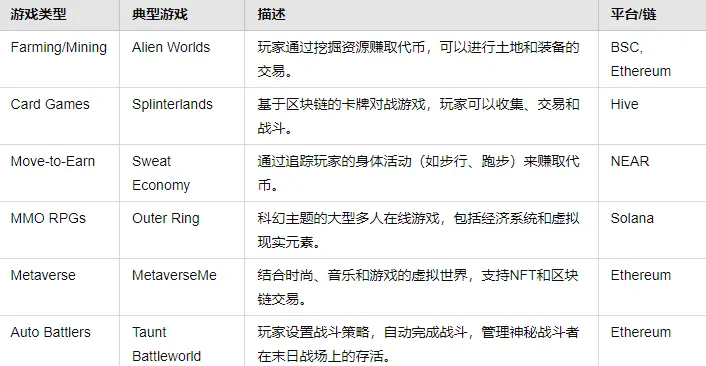
Figure 26: GameFi Game Forms and Typical Games
On DAppradar, the GameFi Matr1x, ranking first in UAW (active user count), is an MMORPG-type game. In the past 30 days, the number of active users has reached as high as 1.92 million, yet the circulating market value is only $49 million. The current market focus is mainly on basic areas such as Layer1 and Layer2 construction, while GameFi leans towards comprehensive technological applications. With breakthroughs in the basic areas, there is still a chance for a second outbreak.
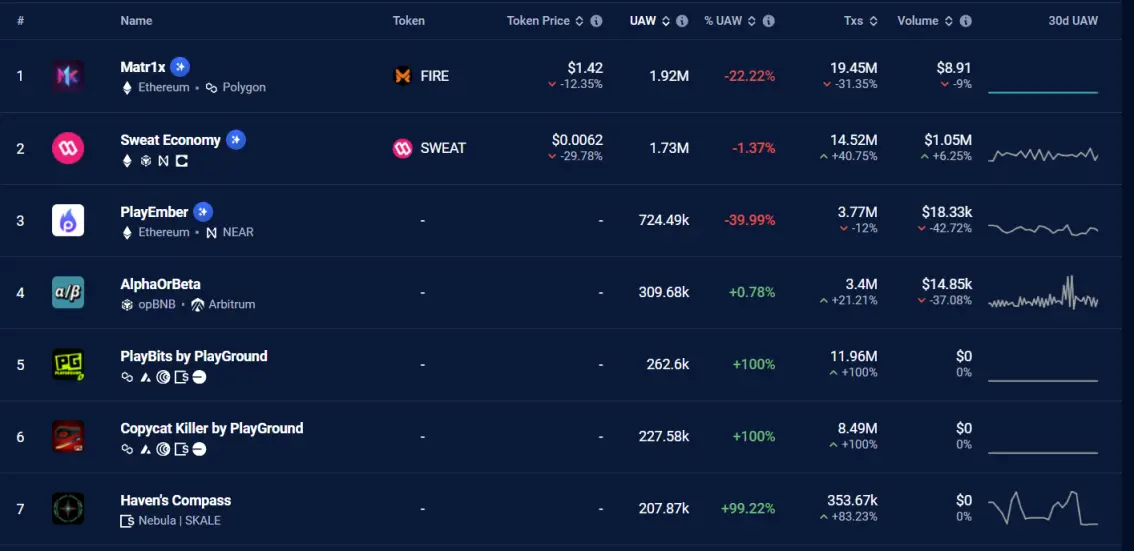
Figure 27: DAppradar GameFi Rankings
Full-chain Games
Full-chain games run all game logic, data, and assets on the blockchain. During the GameFi 1.0 to GameFi 2.0 era, most games only had assets or partial logic on the chain, while full-chain games emphasize complete decentralization and transparency, effectively avoiding issues such as game cheating. The Autonomous World can be seen as a major manifestation of full-chain games, building a virtual world based on blockchain technology, making the rules and operations of the entire world transparent. The future development goal of GameFi is undoubtedly full-chain games.
GameFi+?
In the current market, single GameFi struggles to gain market favor, and integration with AI, IoT, and other technologies may be the breakthrough. A series of GameFi+AI projects such as colony, Nimnetwork, Futureverse, Palio, and Ultiverse have broken the deadlock. Palio, in particular, received a $15 million investment from Binance Labs for the development and integration of AI technology, demonstrating the recognition and pursuit of GameFi+AI projects by major VCs. In addition, the combination of GameFi with hot topics such as IoT and cloud computing is also a major development path.
From Technological, IP Effect, and Playability Perspectives
Axie Infinity developed a pet battle game on the blockchain, inspired by the game "Pokemon," while The Sandbox is a blockchain migration of "Sand" and "Sand Evolution," demonstrating the infinite development potential of traditional IP on the blockchain. Although Axie Infinity and The Sandbox have both experienced severe economic bubbles, their current market values are still as high as $800 million and $700 million, proving their ability to attract real users.
In addition, many game companies plan to introduce blockchain technology into classic games.
- Atari is collaborating with The Sandbox to bring its classic games such as "Centipede" and "Pong" into the metaverse platform. Players can use SAND tokens to participate in and create experiences based on these classic games in The Sandbox.
- Square Enix announced plans to introduce its renowned game IPs, "Final Fantasy" and "Dragon Quest," to the blockchain platform.
- Capcom announced that it will explore ways to bring its well-known games such as "Street Fighter" and "Resident Evil" into the blockchain gaming field.
In the traditional gaming field, the emergence of MOBA games such as League of Legends and Honor of Kings often represents the peak stage of game development. In the GameFi field, the current breakthrough method is to create a game with high playability and a complete financial system. Whoever can first introduce excellent game IPs has the opportunity to gain a first-mover advantage.
Conclusion
GameFi is essentially a combination of DeFi+NFT+Blockchain Game, representing the unified application of blockchain technology and a new stage in the development of games.
GameFi has gone through the 1.0 and 2.0 eras, gradually transforming from past Ponzi schemes to attractive game ecosystems for real users.
Currently, the hotspots in the blockchain industry are focused on basic ecosystem construction such as Layer1 and Layer2, while GameFi is still gathering momentum.
"Full-chain Games" and "GameFi+?" are the development trends of GameFi 3.0.
Investing in GameFi requires attention to its IP, playability, and technological aspects. Only GameFi that can truly attract players has the potential for long-term development.
免责声明:本文章仅代表作者个人观点,不代表本平台的立场和观点。本文章仅供信息分享,不构成对任何人的任何投资建议。用户与作者之间的任何争议,与本平台无关。如网页中刊载的文章或图片涉及侵权,请提供相关的权利证明和身份证明发送邮件到support@aicoin.com,本平台相关工作人员将会进行核查。




